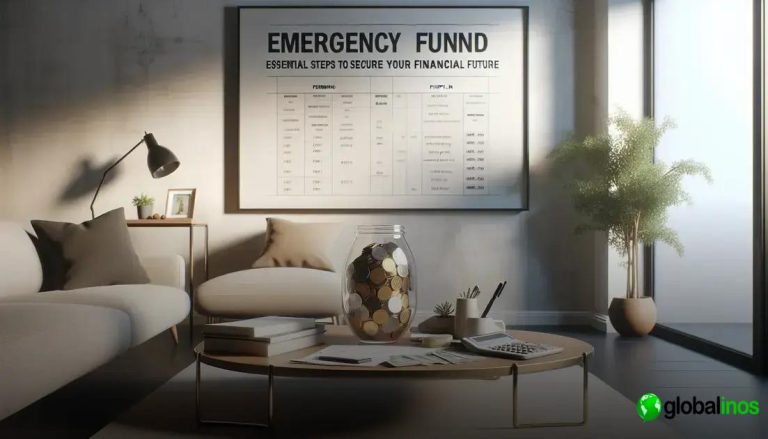Emergency Fund Planning is essential for ensuring your financial security. Life can be unpredictable, and having a reserve to cover unexpected expenses like medical bills or car repairs can be the key to avoiding financial stress.
Without an emergency fund, you might end up relying on credit or loans, leading to debt. Having this reserve brings peace of mind and helps you handle unforeseen situations without compromising your financial health.
Wondering how to get started and how much to save? Keep reading to discover the essential steps for building your emergency fund.
Why you need an emergency fund
Life is unpredictable, and unexpected expenses can arise at any moment. Job loss, medical emergencies, car repairs, and sudden home maintenance are just a few examples of situations where having an emergency fund can provide a financial safety net.
Without an emergency fund, you may find yourself relying on high-interest credit cards or loans, which can lead to debt spirals. An emergency fund ensures you have quick access to cash when you need it the most, preventing financial stress and enabling you to manage unforeseen circumstances with confidence.
Additionally, it offers peace of mind and financial stability, safeguarding your long-term financial health.
How much should you save?

Determining the right amount to save in your emergency fund is crucial. Financial experts suggest having three to six months’ worth of living expenses. This range provides a cushion for unexpected events like job loss, medical emergencies, or significant car repairs. Emergency Fund Planning is key to ensuring you’re prepared for these kinds of situations.
To calculate your ideal emergency fund amount, start by listing your monthly expenses. Include rent or mortgage, utilities, groceries, transportation, insurance, and any other recurring costs. Multiply the total by three to six months. Emergency Fund Planning ensures you account for all your needs, tailoring your savings to your unique situation.
The exact amount you save should reflect your personal circumstances. For example, single-income households may aim for six months of expenses, whereas dual-income households might be comfortable with three months. You should also consider job stability and healthcare needs.
It’s essential to adjust this amount periodically. As your financial situation changes, so should your emergency fund. Regular reviews ensure you remain prepared for any financial surprises.
Remember: The goal is to build a safety net that keeps you afloat during tough times. While it might seem daunting, consistent and disciplined saving will help you achieve this financial milestone.
Where to keep your emergency fund
Choosing the right place to keep your emergency fund is crucial. Emergency Fund Planning involves selecting a location that balances easy access with a safe environment that offers some level of interest. Here are a few options:
High-Yield Savings Accounts
These accounts provide the best of both worlds: accessibility and higher interest rates compared to regular savings accounts. You can typically access your funds online or with a debit card. While the interest earned is minimal, it can be slightly more than traditional savings accounts.
Money Market Accounts
Money market accounts come with a higher interest rate than savings accounts, along with check-writing privileges and debit card access. However, they may require a higher minimum balance.
Certificates of Deposit (CDs)
CDs offer higher interest rates but tie up your money for a fixed period. Opt for short-term CDs if you choose this option. Early withdrawal penalties could mean losing some interest, so only commit funds you won’t need immediately.
Cash Management Accounts
These accounts are often provided by brokerage firms and combine the benefits of checking, savings, and investment accounts. They offer higher interest rates and flexibility but ensure they are FDIC-insured for safety.
Regardless of where you choose to keep your emergency fund, prioritize liquidity and safety to ensure you can access your money when needed without significant penalties or delays. Emergency Fund Planning helps ensure that your money is both secure and readily available in times of need.
Tips to start saving for an emergency fund

To begin your journey towards building an emergency fund, the first step is to evaluate your current financial situation. Emergency Fund Planning starts with understanding where your money is going and identifying areas to make changes.
Analyze Your Income and Expenses
Create a detailed budget to get a clear picture of your monthly income and expenses. Identify areas where you can cut back on discretionary spending, such as entertainment or non-essential shopping. Tracking every dollar helps you understand your spending habits and highlights where adjustments are possible.
Set Realistic Savings Goals
Determine how much you need to save based on your essential expenses, such as rent, utilities, and groceries. Start with a small goal, like saving $500, and steadily increase it as you get more comfortable.
Automate Your Savings
Set up an automatic transfer from your checking account to a dedicated savings account. This ensures that a portion of your income goes directly into your emergency fund without requiring constant effort. Automation simplifies saving and reduces the temptation to spend the money elsewhere.
Reduce Unnecessary Expenses
Look closely at your monthly spending habits. Cancel unused subscriptions, dine out less often, and consider more affordable entertainment options. Redirect these savings toward your emergency fund.
Build the Habit
Consistency is key. Make saving a regular part of your financial routine. Even small, regular contributions can accumulate significantly over time. Establishing this habit early will help you stay committed to your fund-building goals.
Earn Extra Income
Explore side gigs or freelance work to boost your income. The extra money can accelerate the growth of your emergency fund. If you have specialized skills, consider monetizing them during your free time for an additional income stream.
Use Windfalls Wisely
Allocate bonuses, tax refunds, or any unexpected windfalls to your emergency fund. This can provide a substantial boost. Emergency Fund Planning helps you stay on track and maximize your resources to reach your savings goals.
When and how to use your emergency fund
Your emergency fund is there to cover unexpected expenses. These could be sudden medical bills, car repairs, or urgent home maintenance. Do not use it for discretionary spending such as vacations or luxury items. This fund is specifically for essential and unforeseeable expenses that can disrupt your financial stability.
When an emergency strikes, assess the situation carefully. Withdraw only what is necessary to cover the urgent need. Keep track of how much you are using and plan to replenish the fund as soon as possible. Maintain discipline to ensure the fund remains available for future crises.
Remember, the purpose of an emergency fund is to help you navigate through unexpected financial challenges smoothly, without accumulating debt.





